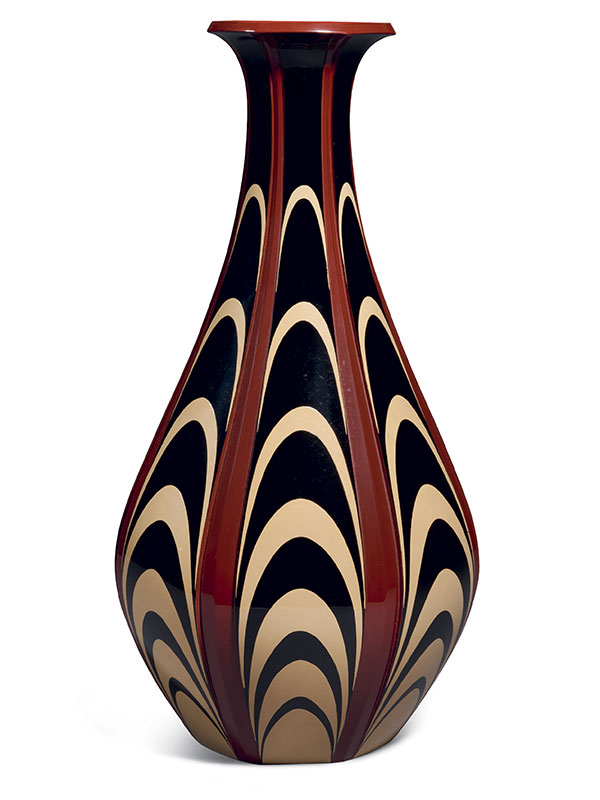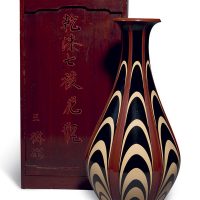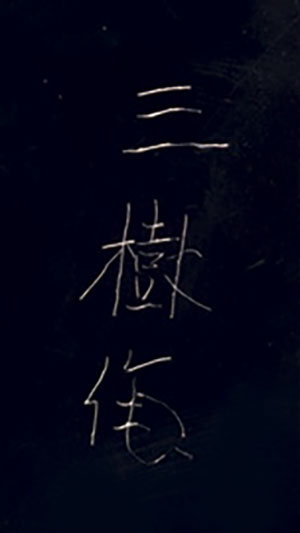Lacquer vase by Mori Miki
Japan, early Showa era, circa 1930 – 1940
A massive and heavy seven-sided dry lacquer (kanshitsu) vase of baluster shape, the sides rising from a flat base, the mouth rim widely flared. The vase is decorated with panels of bow shapes in cream on a black background, separated by bright vermillion bands on the ribs. The vermillion colour extends to the interior. The base, which is lacquered black, is signed with a three-character mark reading Sanju saku (made by Sanju). The vase is contained within its original silk bag and lacquered wood box, which retains its sliding cover and which is fitted with an inner lid. The cover is inscribed Kanshitsu nanaryo kabin and Sanju saku (dry lacquer flower vessel with seven edges, made by Sanju), as is the bag.
The ancient technique of kanshitsu (literally ‘dry lacquer’) is a process whereby a piece of lacquer is shaped by a mould of many layers of hemp cloth soaked in lacquer, which is then removed to leave the object. Mori Miki was the go or art name used by Mori Sanju II, who lived from 1902 – 1970. He was born in Kashiwazaki in Niigata Prefecture and was later adopted by Shigehiro Sanju I. As a young artist Mori Miki studied lacquer for three years in Kanazawa under Asobe Sekisai. At the age of 28 he moved to Tokyo, where he became an independent artist. Mori Miki first participated in the 14th Teiten in 1933 and participated the following year in the 15th Teiten. He was a distinguished lacquer artist who exhibited at both the Kaiso Dai Ikkai Teiten and the Bunten Kansaten in 1936, the 3rd Shin-Bunten in 1939, the Hoshukuten in 1940, and the 4th – 6th Shin-Bunten in 1941 – 1943. From 1940 he was a member of the Tokyo Shitsu Bijutsu Kai (Tokyo Lacquer Fine Arts Association). After the Pacific War he returned to the national stage with the 1st and 2nd Nitten, both held in 1946, the 3rd Nitten in 1947, the 5th in 1949, and the 6th in 1950. At the 3rd Nitten Mori Miki exhibited under his alternate name of Mori Sanju II a high pedestal fruit tray (moriki) with a motif of circles, executed in kanshitsu. This tray is now in the collection of the Philadelphia Museum of Art.1
昭和早期/森山树二代制干漆花瓶
此瓶撇口,鹅颈,鼓腹,平底。器身起六棱,棱线以红漆髹;六面开光,其内以黑漆为底,装饰黄色曲线,底部刻“三树制”款。干漆是一种古老的漆器工艺,匠人以麻布浸漆事先塑造出器物形状,继而漆髹装饰,最后将麻布移除,仅留下纯漆质的器物。森山树(1902-1970)出生于柏崎市,后被森山树一代收养。年轻的他在金泽师从山崎觉太郎学习漆艺,28岁时移居东京并成为一名独立艺术家,其作品入选第14及15届日本美术展览会(帝国美术展览会),此后其作品多次亮相日本国家级展览。1940年森山树二代被选为东京漆艺协会理事。



